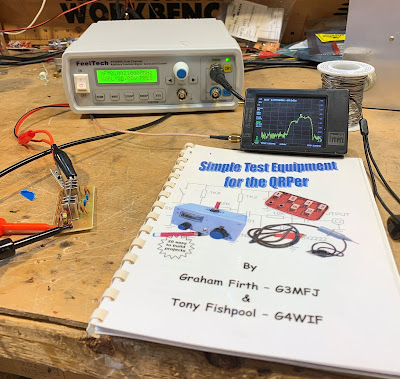Podcasting since 2005! Listen to Latest SolderSmoke
Monday, November 8, 2021
Save $2970! Build this $30 DIY Microphone!
Sunday, November 7, 2021
JPL, Mars Helicopter, Cube Sats, Ham Radio and more: N5BF talks to Eric Guth 4Z1UG
Here is Eric's page on this interview, with useful show notes:
https://www.qsotoday.com/podcasts/n5bf
I like to listen to Eric's shows on YouTube -- here is the YouTube recording of the N5BF interview:
https://www.youtube.com/watch?v=Fbr4jE11vfg
Here is N5BF's ham radio web site:
http://cbduncan.duncanheights.com/HamRadio/HamRadio.html
Here is the club page of the San Bernardino Microwave Society:
http://www.ham-radio.com/sbms/
Thanks to Eric and Courtney!
Saturday, November 6, 2021
M0NTV's "Crystal Filters for the Fearful" (video)
Friday, November 5, 2021
The Importance of Keeping the Noise FLAT
Wednesday, November 3, 2021
Tuesday, November 2, 2021
Farhan's Amazing Knack Story: From a Boyhood SW Receiver to the Design of the sBITX SDR
-- Farhan talks about his practice of taking the pictures of new rigs with the new rig sitting atop the book that was most important in its design and construction. FB.
-- I was really blown away by Farhan's presentation of how the uBITX advertisement was inspired by and in many ways based on the Heathkit ad for an HW-101. Amazing.
-- I learned a lot from Farhan's discussion of SDR theory. I pledge to spend more time with this. I really like Farhan's hybrid HDR/SDR approach.
-- But I have a question: Farhan seems to say that we'd need a big expensive GOOGL computer to do the direct sampling HF SDR. But doesn't the little RTL-SDR do just that? Without a GOOGL?
-- Great to see Wes's AFTIA being used in the sBITX.
-- Really cool that Farhan has his mind on VHF transverters when designing the sBITX. I liked use of the TCXO module to free up one of the Si5351 clock outputs. FB. And great to include an idea from Hans in this rig.
Thanks very much to Farhan (who stayed up until 3 am to do this!) and to the RSGB for hosting.
Sunday, October 31, 2021
Buy a Real Sputnik Satellite! Let's Put Sputnik Back in Orbit!
Here's the description:
---------------
Laboratory Test Model of "Sputnik 1 EMC/EMI", 1957
1:1 scale test model of the satellite "Sputnik-1", serial no. "0K6-1/004/1957", with built-in transmitter (including modern 12-volt power supply), polished stainless-steel sphere, consisting of two threaded hemispheres of approx. 23 in. diameter with two pairs of antennae of 95 in. and 105 in. at an angle of 35 degrees to the axis, on stand with O-ring, stand approx. 59 in. high, stand and model together approx. 79 in. high, accompanied by a Tesla Maj 620A radio receiver, manufactured in Prague c. 1956, restored working condition, including replacement of the silver-zinc battery with a modern alternative and a new metal casing for the electronic transmitter. Note: Built at the Experimental Design Bureau-1 (OK?-1/OKB-1) factory, also known as S.P. Korolev Rocket and Space Corporation Energia, Koroljow, Soviet Union, in 1957, shortly before the launch of Sputnik-1. - An impressive artefact from the dawn of the space age, of which few models are known. - Provenance: From the collection of Dr. Frank Malina, USA/CSSR.
Start Price: EUR 85.000
Here's my suggestion: Musk or Bezos or Branson should buy this thing, fix it up a bit, and put it back in orbit. So we can listen to it again. I know a version of this was done back in 1997. But I think we should do it again, this time with the actual test model.
Here are the earlier SolderSmoke blog posts about Sputnik and Sputnik-related projects:
https://soldersmoke.blogspot.com/search?q=Sputnik
Steve Silverman sent the auction posting to me. Thanks Steve.
It just so happens that earlier in the week I was out at the Air and Space Museum facility near Dulles Airport, where I saw this flight backup of the Vanguard satellite:
Saturday, October 30, 2021
Using Noise to Sweep a Filter with the TinySA
Wednesday, October 27, 2021
Why Does Solder Smoke Always Go Right Into Your Face? Now We Know
How to Listen with your TinySA
Tuesday, October 26, 2021
SETI, Proxima Centauri, The Parkes Dish, and Intermodulation Distortion?
A cosmically interesting troubleshoot. But I'm not sure about their explanation. Why would the intermod disappear when they moved the Parkes Radio Telescope off of Proxima Centauri?































